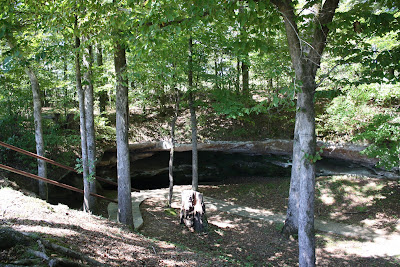 We got up this morning and headed out on a three state trip. We started out on the Natchez Trace in Tennessee and took a side trip on the Old Natchez Trace. Very narrow and tranquil.
We got up this morning and headed out on a three state trip. We started out on the Natchez Trace in Tennessee and took a side trip on the Old Natchez Trace. Very narrow and tranquil. 
The early interstate road building venture produced a snake infested, mosquito beset, robber haunted, Indian traveled forest path. When the trail became to water bogged that wagons could not be pulled through, travelers cut new paths through the nearby woods. Here we saw three cuts made to avoid mud into which the oxcarts and wagons sunk making progress slow or impossible. You can just imagine how deep these were back in the day. There were three trails cut not 3 feet between then here.

Went into Alabama

Colbert
Stand
George Colbert
operated a ferry that crossed the Tennessee River from 1800 to 1819. His stand or inn offered travelers a warm
meal and shelter during their journey on the Old Trace. Colbert looked after his own well-being and
once charged Andrew Jackson $75,000 to ferry his Tennessee army across the
river.. That was a whole lot of money
back in the day. The stand would have been located in the inlet you can see in the pic above. We are on the bridge.
 Another state line into Mississippi to the visitor center for the Natchez Trace to get my stamp in my book. Done Done Done
Another state line into Mississippi to the visitor center for the Natchez Trace to get my stamp in my book. Done Done Done Bear Creek Mounds According to people in the "know" there were peoples here 1000's of years ago that built temples to house there religious artifacts and this mound was the base for that temple,
Bear Creek Mounds According to people in the "know" there were peoples here 1000's of years ago that built temples to house there religious artifacts and this mound was the base for that temple,  This is a spring that dissolved the limestone around it and produced this cave. They figure the Indians came for the water and rock
This is a spring that dissolved the limestone around it and produced this cave. They figure the Indians came for the water and rock  This is part of the cave formation. They figured the limestone dissolved underground causing the ground to collapses into itself. causing a sink hole. This happens a lot in areas where limestone is prevalent.
This is part of the cave formation. They figured the limestone dissolved underground causing the ground to collapses into itself. causing a sink hole. This happens a lot in areas where limestone is prevalent.  For the life of me I can not remember the name of this river, but they built locks so ships could travel up river from New Orleans 400 + miles.
For the life of me I can not remember the name of this river, but they built locks so ships could travel up river from New Orleans 400 + miles. This is the National Cemetery. So many died here and time was of the essence so all were buried on the battle field. I was sitting in the visitor center when an elderly lady came in and ask if they could help her locate the grave of her grandfather. They said yes looked things up on the computer and found that her grandfather did die here in this battle, but that he was in an unmarked grave. She said that 2/3 of the dead were buried in unmarked graves. She said her grandfather was a union soldier and she could locate the regiment he was in and the location of that regiment when they were here at Shiloh so the lady could drive to the location where he may have died. I had to leave before all of that information was found out.
This is the National Cemetery. So many died here and time was of the essence so all were buried on the battle field. I was sitting in the visitor center when an elderly lady came in and ask if they could help her locate the grave of her grandfather. They said yes looked things up on the computer and found that her grandfather did die here in this battle, but that he was in an unmarked grave. She said that 2/3 of the dead were buried in unmarked graves. She said her grandfather was a union soldier and she could locate the regiment he was in and the location of that regiment when they were here at Shiloh so the lady could drive to the location where he may have died. I had to leave before all of that information was found out. John Clem, above, served as a drummer boy at Shiloh at 10 years of age; one of the youngest participants in the battle. He retired from the army as a major general not at age 10, but much older.






No comments:
Post a Comment